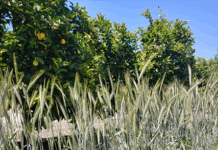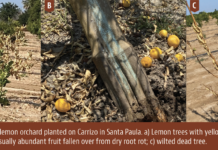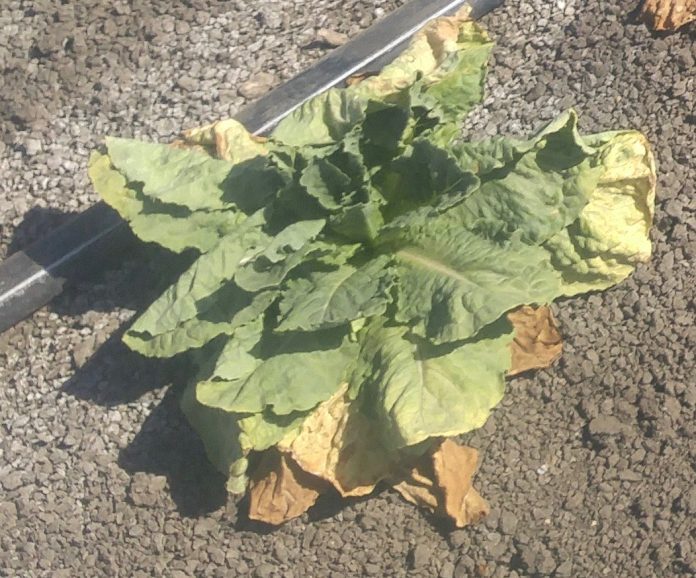
Lettuce dieback is a soilborne virus disease known to cause significant losses for lettuce production throughout all western growing regions. The disease was originally described in the Salinas Valley in the late 1990s following severe flooding along the Salinas River but has now been found throughout coastal and inland lettuce production regions of California, the winter production region in southwestern Arizona and Imperial Valley, California.
The disease is most prevalent on romaine lettuce but is known to occur on all non-crisphead (iceberg) lettuce types. Most modern crisphead lettuces are resistant, and an increasing number of romaine cultivars now carry resistance as well. Symptoms of lettuce dieback include yellowing and necrosis of outer leaves, stunted growth and death of affected plants (Fig. 1). Plants infected young may fail to develop beyond the 8 to 10 leaf stage, but symptoms can develop at any point in the growing season, and fields often exhibit a range of plant sizes with some plants appearing healthy and maturing normally, while others become stunted and never fully develop (Fig 2).
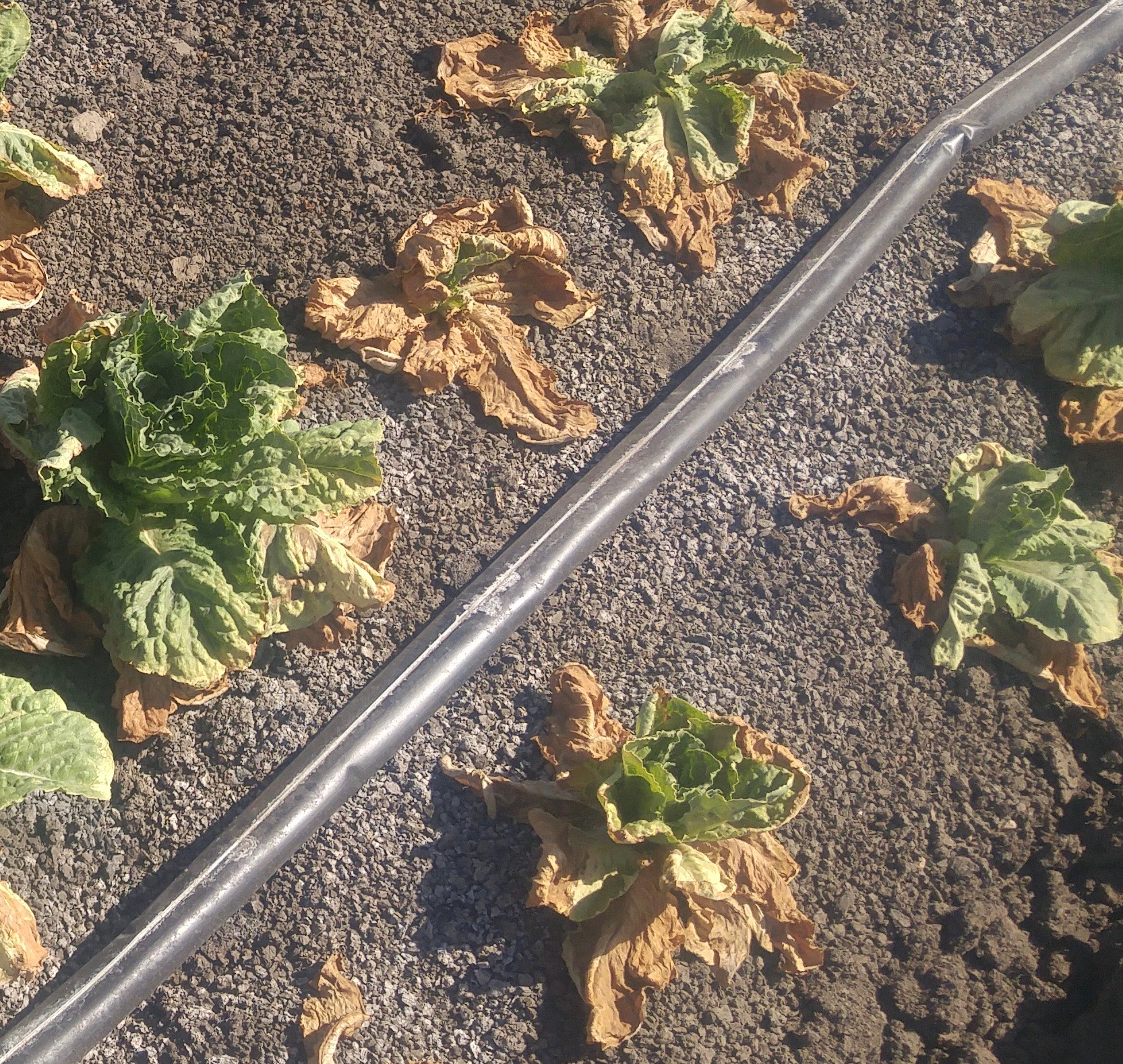
Initial symptoms begin with yellowing and necrosis (death) of small veins in outer leaves, with the necrosis expanding into larger areas within and between veins. Inner leaves of the head usually retain their color, but some romaine varieties may also exhibit bright chlorotic flecks within veins of leaves at the center of the head that resembles tiny stars. These are most visible when affected leaves are held up to a light source (Figure 3).
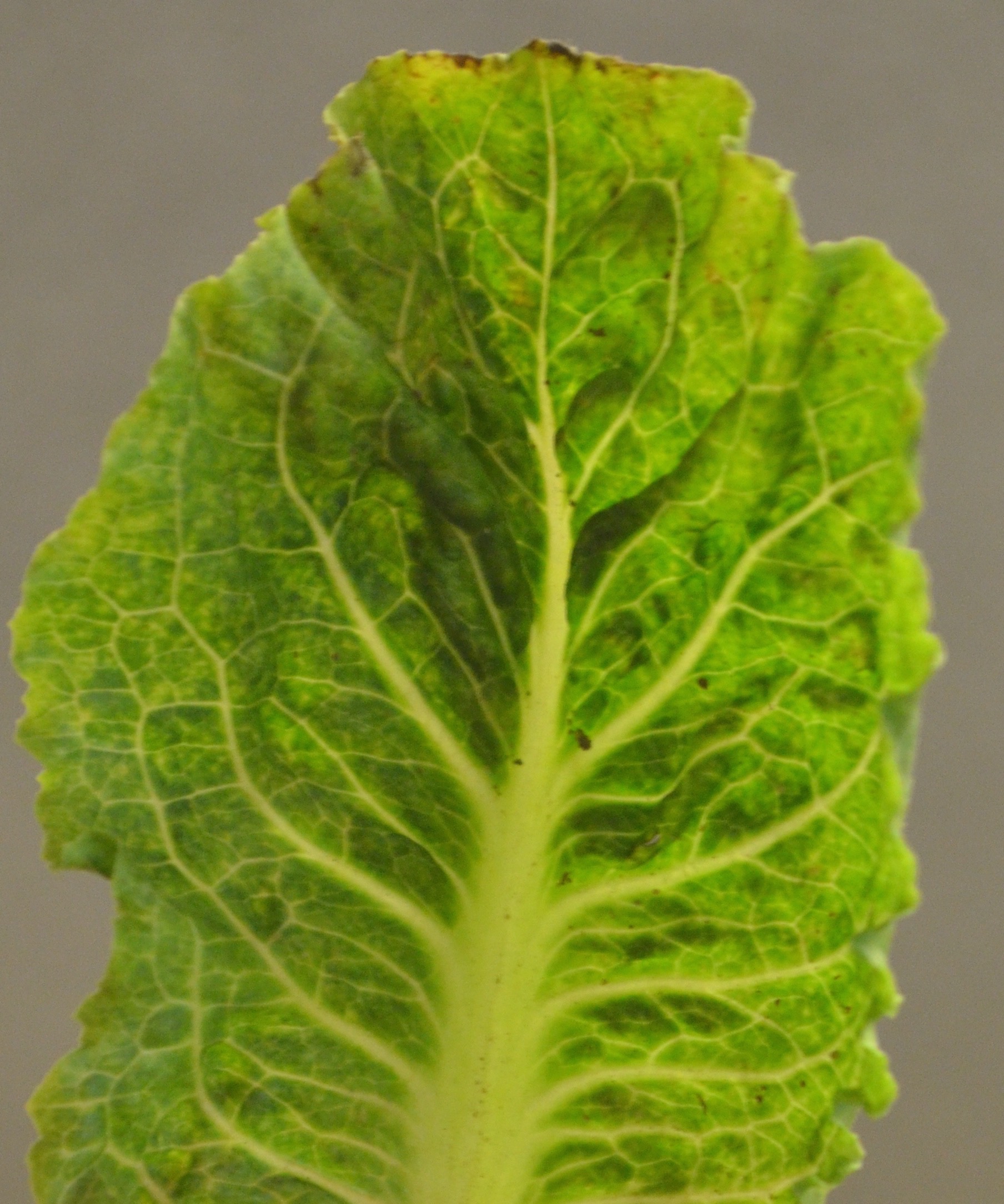
This vein-flecking symptom is not always present on infected romaine, but when observed it is an excellent diagnostic indicator. The vein flecking symptom is less common on other types of lettuce and is more difficult to observe on red lettuce. Losses resulting from lettuce dieback can range from a few plants to complete loss of crop. In most severely affected fields lettuce heads are not harvested because the plants will not meet quality standards. Symptoms of the disease are frequently found in low lying areas with poor drainage, in areas near rivers, on recently flooded land, and in areas where soil has been dredged from a river or ditch and spread onto adjacent fields.
Symptoms of lettuce dieback can be mistaken for those of other diseases, particularly lettuce drop, a disease caused by a fungus, and symptoms of two viruses transmitted by thrips. It is fairly easy to differentiate lettuce drop from lettuce dieback because lettuce drop, caused by fungi in the genus Sclerotinia, results in a soft rot, outer leaves often flatten against the ground, and heads easily separate from the root, whereas with lettuce dieback the root remains firmly attached to the head. The two thrips-transmitted viruses, impatiens necrotic spot virus (INSV) and tomato spotted wilt virus (TSWV), also cause necrotic (dead) patches on leaves of infected lettuce plants that resemble symptoms of lettuce dieback, and therefore it can be difficult to differentiate the two diseases. Diagnostic tests can be used to differentiate lettuce plants infected with these viruses from those with lettuce dieback disease. Serological detection methods including commercially available immunostrips that can be used in the field to determine infection with INSV or TSWV, but immunostrips are not available for the viruses associated with lettuce dieback disease. Therefore, confirmation of lettuce dieback requires laboratory testing, which can include both molecular biology and serological methods. In some cases, lettuce plants may be infected by multiple pathogens simultaneously and this may complicate diagnosis.
Lettuce dieback is probably a very old disease of crisphead (iceberg) lettuce that disappeared for many years before reemerging with a new name as a disease of other lettuce types. In the 1930s a disease known as brown blight devastated lettuce production in California with symptoms that closely resembled those of lettuce dieback based on descriptions and illustrations at the time.
Iceberg lettuce was the main type of lettuce grown in the 1930s, and it suffered severe losses from brown blight for many years until a source of resistance was identified by a USDA scientist, Ivan Jagger. This source of resistance was eventually bred into all subsequent iceberg lettuce types, beginning with the variety Imperial, and this eliminated the threat from brown blight. In the early 2000s, after the appearance of lettuce dieback, USDA scientists identified a source of resistance to lettuce dieback from the crisphead lettuce variety Salinas, and through genetic studies found that the source of resistance to lettuce dieback is also present in the brown blight-resistant lettuces developed by Jagger over 70 years earlier, but was not in earlier susceptible lettuce varieties. In other words, only crisphead lettuce varieties that predate the variety Imperial could develop symptoms of lettuce dieback. This suggests the two diseases may actually be the same. The resistance to lettuce dieback has been incorporated into several romaine lettuce varieties, as well as some leaf and butter lettuce varieties, but there remain many lettuces that are susceptible to lettuce dieback disease.
Since the late 1990s, lettuce dieback has been believed to be caused by infection of lettuce plants with either of two viruses from the genus Tombusvirus; tomato bushy stunt virus (TBSV) and Moroccan pepper virus (MPV). These viruses are absent from healthy lettuce but have been found regularly in association with lettuce dieback disease. However, there have been numerous situations in which neither virus was found in association with obvious disease symptoms. Furthermore, it has not been possible to consistently and easily reproduce disease symptoms when lettuce is inoculated with either virus in a laboratory setting, raising the possibility that an additional virus may contribute to causing lettuce dieback disease.
In an attempt to identify a possible additional virus contributing to lettuce dieback disease, high throughput sequencing (HTS) was used on several lettuce plants exhibiting dieback symptoms, which led to the identification of a new virus consistently associated with diseased plants but not with healthy lettuce plants. This novel virus was most closely related to a recently identified and poorly characterized virus from watermelon in China, watermelon crinkle leaf associated virus, which was found using the same HTS approach.
The newly identified lettuce virus, tentatively named lettuce dieback associated virus (LDaV) shares an extremely low genetic relationship with the watermelon virus, which suggests that although the two viruses are related, they are very distantly related to one another. Using a combination of HTS and traditional DNA sequencing the genome of the new virus, LDaV, was assembled and methods were developed to allow rapid detection of the virus from lettuce leaf extracts using RT-PCR, a routine laboratory diagnostic method. LDaV has now been found not only in lettuce showing dieback symptoms collected recently, but it has also been found in older archived samples of lettuce nucleic acid collected from plants showing dieback symptoms over the past 20 years, including many that also contained MPV or TBSV. To date, LDaV has not been found in healthy lettuce plants. Interestingly, genetic comparison showed that LDaV isolates collected from coastal California production regions are closely related to one another, and desert isolates from Arizona and Imperial Valley, California also are closely related to one another. However, coastal and desert isolates differ genetically from one another, suggesting perhaps some regional adaptation of the virus to plants grown under the different climatic conditions.
Further research will clarify the role of LDaV in lettuce dieback disease and how it relates to the two tombusviruses, MPV and TBSV, that have long been linked to the disease. Studies to date, however, strongly suggest a role for LDaV in lettuce dieback disease development, and research is in progress to clarify the ability of LDaV to produce lettuce dieback symptoms when inoculated to lettuce plants, as well as whether or not the new virus can infect lettuce plants carrying a gene for resistance to lettuce dieback.











